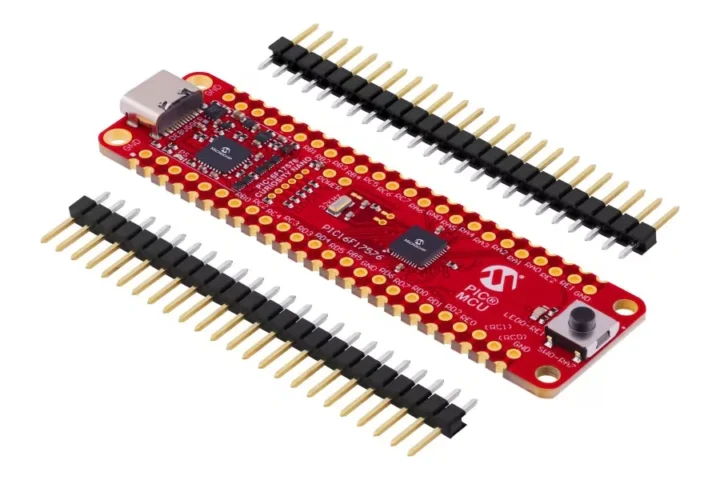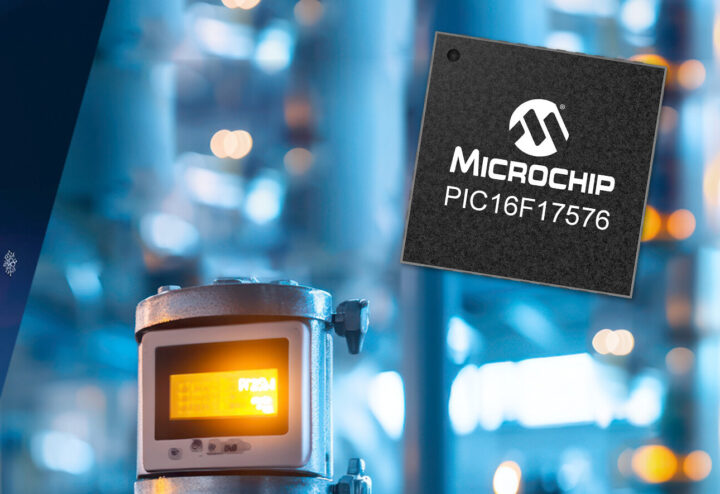Microchip PIC16F17576 8-bit MCUs are designed for low-cost and low-power analog sensors. They integrate a low-power comparator and voltage reference combination that can operate while the MCU core is in sleep mode, consuming less than 3.0 µA of current during analog measurements.
The PIC16F17576 microcontrollers are equipped with up to four operational amplifiers (op amps) with software-controlled gain ladders, and a 12-bit differential ADC with automated averaging. Key applications include vibration and strain measurement, flow metering, gas detection, cold asset tracking, and motion sensing.
PIC16F17576 specifications:
- Core – C Compiler Optimized RISC Architecture @ 32 MHz
- Memory and Storage
- Up to 2 KB of data SRAM
- Up to 28 KB of program flash memory
- Up to 256 bytes of data EEPROM memory
- Programmable code protection and write protection
- Digital Peripherals
- 2x Capture/Compare/PWM (CCP) Modules (16-bit resolution for Capture/Compare modes; 10-bit resolution for PWM mode)
- 2x 16-bit PWM
- 4x Configurable Logic Cells (CLC)
- 1x Complimentary Waveform Generator (CWG):
- Configurable 8/16-Bit timer (TMR0)
- 2x 16-bit timers (TMR1/3) with gate control
- Up to 3x 8-bit Timers (TMR2/4/6) with Hardware Limit Timer (HLT)
- Numerically Controlled Oscillator – Input clock up to 64 MHz
- Programmable CRC with memory scan:
- 2x Enhanced Universal Synchronous Asynchronous Receiver Transmitters (EUSART); RS-232, RS-485, LIN compatible
- 2x Host Synchronous Serial Ports (MSSP) for SPI or I2C
- Peripheral Pin Select (PPS) for pin mapping of digital I/O
- Up to 35x I/O pins
- 1x input-only pin
- 1x External Interrupt pin
- Analog Peripherals
- Differential Analog-to-Digital Converter with Computation (ADCC) with 12-bit resolution, up to 300 ksps sample rate, up to 35x external input channels, 7x internal input channels
- 2x 10-bit Digital-to-Analog Converters (DAC)
- 2x Comparators (CMP): 1x High-Speed Comparator (CMP1) with 50ns response time, 1x Low-Power Comparator (CMPLP1):
- Up to 4x operational amplifiers:
- 2x Fixed Voltage References (FVR) – Selectable 1.024V, 2.048V, and 4.096V output levels
- Low Power Voltage Reference (VREFLP) – Nominal 1.024V output; independent 6-bit DAC
- Clocks
- High-Precision Internal Oscillator Block (HFINTOSC) up tp 32 MHz:
- Internal 31 kHz Oscillator (LFINTOSC)
- External 32 kHz Secondary Oscillator (SOSC)
- External High-Frequency Clock Input:
- 3x Crystal/Resonator modes
- 2x External Clock (EC) Power modes
- 4x PLL available for external sources
- Fail-Safe Clock Monitor
- Oscillator Start-up Timer (OST)
- Programming/Debugging
- 2-pin In-Circuit Serial Programming (ICSP)
- 2-pin In-Circuit Debug (ICD) with 3x breakpoints
- Misc
- Low-Current Power-on Reset (POR)
- Configurable Power-up Timer (PWRT)
- Brown-out Reset (BOR)
- Low-Power Brown-out Reset (LPBOR)
- Windowed Watchdog Timer (WWDT)
- Supply Voltage – 1.8V to 5.5V
- Power savings modes and features
- Doze – CPU and Peripherals Running at Different Cycle Rates (typically, the CPU is lower)
- Idle – CPU Halted While Peripherals Operate
- Sleep – Lowest power consumption, reduced noise while performing ADC conversions
- < 900 nA typical @ 3V/25°C (WDT enabled)
- < 600 nA typical @ 3V/25°C (WDT disabled)
- Peripheral Module Disable (PMD) – Selectively disables hardware modules to minimize active power consumption
- Analog Peripheral Manager – Switches analog peripherals on and off as needed
- Active power consumption
- 48 µA typical @ 32 kHz, 3V/25°C
- < 1 mA typical @ 4 MHz, 5V/25°C
- Packages – 28-pin SPDIP, 28-pin SSOP, 28-pin VQFN, 40-pin PDIP, 40-pin QFN, and 44-pin TQFP
- Temperature Range
- Industrial: -40°C to 85°C
- Extended: -40°C to 125°C

There are twelve devices part of the PCI16F17576 family with different RAM and flash configurations, number of I/Os pins, ADC, op amps,timers, etc…
The PIC16F17576 MCUs are supported by the MPLAB X IDE and the MPLAB Code Configurator, allowing designers to manage the functionality of the APM and analog peripherals. The easiest way to get started is to get the Microchip PIC16F17576 Curiosity Nano evaluation kit (EV14L29A) with a PIC16F17576 microcontroller with 28KB flash and 2KB SRAM, a user switch, a user LED, an on-board debugger with two logic analyzer channels (DGI GPIO), and a USB-C port.

Microchip says the PIC16F17576 microcontrollers are available now, starting at 57 cents each in 10,000-unit quantities, while the curiosity development board goes for $9.99. More details may be found on the product page and the press release.
Thanks to TLS for the tip.

Jean-Luc started CNX Software in 2010 as a part-time endeavor, before quitting his job as a software engineering manager, and starting to write daily news, and reviews full time later in 2011.
Support CNX Software! Donate via cryptocurrencies, become a Patron on Patreon, or purchase goods on Amazon or Aliexpress







Typo.
An op amp is an operati*onal* amplifier, not an operati*ng* amplifier.
> 2x 10-bit Digital-to-Analog Converters (DAC)
It’s like they’re not even trying at this point…
What would you need? Is it about the number of DACs or their resolution?
Whether it’s hall effect, lidar or even pressure sensors, all the new sensors need at least 12-bit precision for western players to compete against legacy, cloned-in-China designs.
e.g. If you have 6 or even 9 12-bit hall effect sensors on the ADCC inputs piping out to a couple of stepper motors, you’re going to want the steppers at 12-bit as well. Otherwise, you can just use cheaper sensors -> cheaper micro -> cheaper motor -> Made-in-China.
Crazy how 8-bit MCUs are multiple-times the cost of 32-bit low-end RISC-V MCU’s these days, I guess the IP cost is now multiple times that of the actual hardware.
> I guess the IP cost is now multiple times that of the actual hardware.
Here you’re mostly paying for the peripherals. Not the ISA licensing.
Yeah, $.57 each is in CH32V203 terratory: 144MHz 32 bit RISC-V with integer multiply/divide, 64K flash, 20K SRAM and industry standard peripherials.
For anyone who’s programmed the PIC, you know the peripherials are legacy nightmares that are trying to be compatable back to the OTP/EPROM parts of the 80/90s. They are an absolute pain to work with. The only reason to use a PIC is because you’ve always used a PIC and don’t like new things.